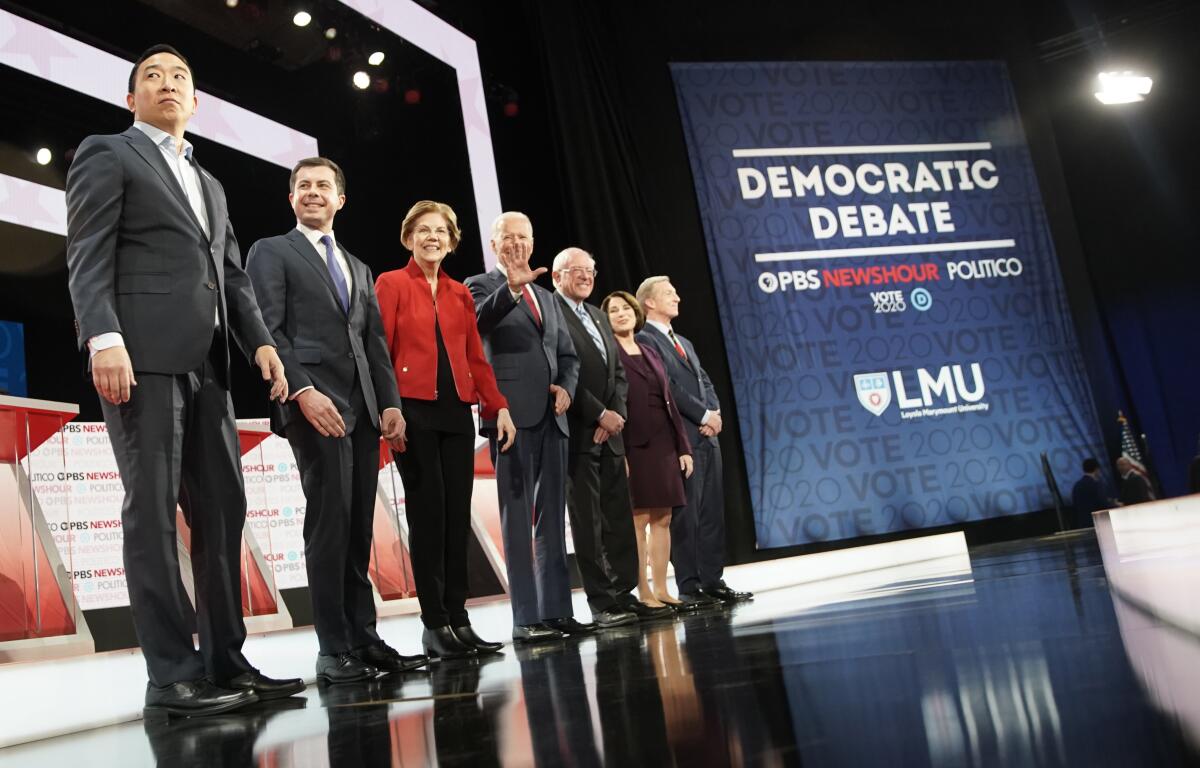Op-Ed: Democrats are headed toward a white nominee. The vice president needs to be a person of color

Julian Castro announced he was withdrawing from the Democratic presidential primary Jan. 2. Despite a strong progressive record, his campaign never attracted much media attention or voter loyalty.
He leaves behind an increasingly white field of candidates. The last presidential debate, in December, included only one person of color, tech executive Andrew Yang. So far, Joe Biden, Pete Buttigieg, Amy Klobuchar, Tom Steyer, Bernie Sanders and Elizabeth Warren — all white — have qualified for Tuesday’s debate in Des Moines. Of the black candidates who entered the race, New Jersey Sen. Cory Booker dropped out of the race Monday, and former Massachusetts Gov. Deval Patrick, has struggled to gain traction. Tulsi Gabbard, who is Samoan American, likewise didn’t make the cut. Neither did Yang.
The Democratic Party is about 40% people of color, but its top tier presidential candidates are 100% white.
A diverse party needs diverse representation. The best way to ensure that for the future is for the eventual 2020 Democratic presidential candidate to choose a person of color for his or her vice president. Although it may not seem crucial, the VP slot can have a huge effect on the fate and the future of the party. Democrats should start using it specifically to elevate nonwhite politicians and party leaders.
Vice presidents generally get picked for their appeal to a particular set of voters or to fill a gap in the presidential nominee’s resume. When Hillary Clinton picked Sen. Tim Kaine as her running mate in 2016, pundits speculated the choice was meant to help her in the contested state of Virginia, Kaine’s home territory. In 2008, Barack Obama’s team believed Biden, twice chairman of the Senate Foreign Relations Committee, would reassure voters that an Obama administration could handle global affairs, despite the president’s relatively slim foreign policy resume.
In truth, there’s little evidence that vice presidential candidates make much difference in who wins the presidency. But they do have an impact — on later elections. Vice presidents frequently become presidents themselves.
Since 1945, of the 13 elected presidents, four have been succeeded by their vice presidents. Another (Eisenhower) saw his VP (Richard Nixon) eventually become president — just not as his immediate successor. Bill Clinton’s VP (Al Gore) won the popular vote and came within a hair of defeating George W. Bush. And of course, at the moment, Biden, Barack Obama’s vice president, is the Democratic presidential front-runner.
Biden’s campaign is especially relevant. Some pundits believe Obama picked Biden in 2008 partly because Biden seemed to be too old to run for president — he would strictly be Obama’s wingman, not pursuing a personal political agenda.
In 2019, Obama reportedly tried to dissuade Biden from running, perhaps because of his age and his propensity for gaffes. But Biden’s name recognition, and his association with Obama’s winning campaigns, has given him a huge advantage over his rivals. Because he was vice president, and because he was on the ticket when Obama won, people see him as presidential and electable.
Biden’s success despite his shortcomings shows just how important a vice presidential nod can be. It proves the point: The VP slot is an crucial way to bring the party’s leadership in line with its constituents.
Obama did win the presidency without being vice president; it’s possible, just more difficult. Now, if Castro, Kamala Harris, Cory Booker or Stacy Abrams is on a winning, or even a losing presidential ticket, they will have gained in name recognition and gravitas for the next go-round. It simply will seem like less of a reach for people of color to lead the party.
President Trump’s campaigns and his presidency turn on questioning the Americaness of people of color, from a Chicago judge of Mexican heritage to minority members of Congress. The more the Republican Party reflects Trump’s prejudices, the more the Democrats must counter them.
An all-white debate stage isn’t a great way to send the message that Americans of all races, backgrounds and ethnicities belong here, and that Democrats will fight for them. In the future, we need presidential nominees of color, and one way to get them is to start appointing vice presidential candidates of color now.
Castro has endorsed Elizabeth Warren. Should she be the party’s nominee, she could reward him with the VP slot. If they defeat Trump in 2020, Castro would be well positioned to run for president again in eight years, when he’d be 53. And as a former vice president, he’d be much more likely to win.
Noah Berlatsky is the author of “Wonder Woman: Bondage and Feminism” and a contributing writer to the Atlantic.
More to Read
Updates
8:37 a.m. Jan. 13, 2020: This op ed has been updated to reflect Sen. Cory Booker’s withdrawal from the Democratic presidential primary race.
A cure for the common opinion
Get thought-provoking perspectives with our weekly newsletter.
You may occasionally receive promotional content from the Los Angeles Times.










